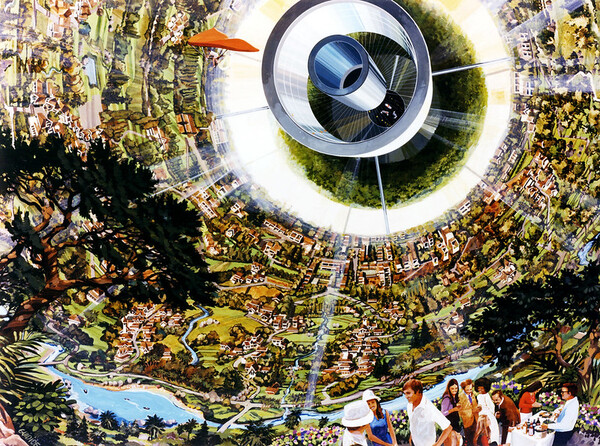This article explores: The design and engineering behind Bernal Spheres: Advantages and challenges for space habitats. Find out more about Design And Engineering Bernal Spheres.
The concept of space habitats has long been a topic of fascination for scientists and engineers.

In the 20th century, physicist Gerard K. O’Neill proposed the idea of building space habitats in the form of Bernal Spheres, large rotating structures that would provide a self-sustaining environment for human habitation in space.
The Bernal Sphere design offers several advantages compared to other space habitats, such as artificial gravity, a large living space, and a self-sustaining environment.
However, designing and building a Bernal Sphere also poses significant engineering challenges, such as developing effective life support systems, creating artificial gravity, and providing reliable power generation and storage.
In this article, we will explore the design and engineering behind Bernal Spheres and discuss the advantages and challenges of this type of space habitat.
How Can We Design A Bernal Sphere Habitat?
A Bernal sphere habitat is a hypothetical space habitat first proposed by scientist John Desmond Bernal in 1929.
It is a spherical space colony that rotates around its axis to create artificial gravity on the inner surface.
Designing a Bernal sphere habitat requires careful planning, engineering, and consideration of the unique challenges of living in space.
Here are the steps to design a Bernal sphere habitat:
Determine the purpose and size:
The first step is to determine the purpose of the habitat and the number of people it needs to support. The size of the sphere will depend on this and should be large enough to provide adequate living space, facilities, and resources.
Choose a location:
The habitat should be placed in a stable orbit around a planet or moon. The location should have access to resources such as sunlight, water, and minerals.
Design the structure:
The sphere should be designed with the right materials to withstand the stress of rotation and the environment of space. The outer shell should be made of a strong, lightweight material such as Kevlar or carbon fiber.
Create a habitat ring:
The inner surface of the sphere should be divided into two parts. The upper part should be a transparent dome that allows sunlight to enter and the lower part should be a ring-shaped living area where people will reside. The habitat ring should be wide enough to provide living space and facilities.
Plan the infrastructure:
The habitat should have all the necessary infrastructure, including life support systems, water and waste management systems, power generation and storage systems, and communications systems.
Provide artificial gravity:
The sphere should rotate around its axis to create artificial gravity. The rotation speed should be carefully calculated to provide the right amount of gravity for human habitation.
Plan transportation:
The habitat should have transportation systems to move people and resources to and from the sphere. This may include space shuttles, cargo vehicles, and other transport systems.
Plan for emergencies:
The habitat should have emergency systems and procedures in place to deal with any unexpected situations.
Plan for maintenance:
The habitat will require regular maintenance and repairs. This should be planned for and the necessary equipment and personnel should be available.
Test and refine the design:
Once the design is complete, it should be tested and refined to ensure it meets the requirements for human habitation in space. This may involve building a prototype or conducting simulations.
What Advantages Does A Bernal Sphere Habitat Provide?
The Bernal Sphere habitat provides several advantages for long-term space missions, including artificial gravity, a large living space, a self-sustaining environment, protection from radiation, access to resources, and sustainable energy production.
A Bernal Sphere habitat provides several advantages compared to other space habitats, including:
Artificial gravity:
The rotating habitat ring of the Bernal Sphere can provide artificial gravity, which is essential for human health and well-being. Studies have shown that prolonged exposure to zero gravity can lead to a range of health problems, including bone and muscle loss, cardiovascular problems, and impaired vision. The Bernal Sphere’s artificial gravity can help mitigate these health risks.
Large living space:
The Bernal Sphere can provide a much larger living space than other space habitats, such as space stations or lunar bases. The habitat ring can be several kilometers in diameter, providing ample room for living quarters, laboratories, and other facilities.
Self-sustaining environment:
The Bernal Sphere can provide a self-sustaining environment for human habitation. This includes developing effective life support systems that can provide air, water, food, and waste management for the occupants. A self-sustaining environment is critical for long-term space missions, such as colonization or exploration.
Protection from radiation:
The Bernal Sphere’s thick outer shell can provide protection from the harmful radiation of space. This is important for the health and safety of the occupants, as prolonged exposure to radiation can lead to cancer and other health problems.
Access to resources:
The Bernal Sphere can be located in close proximity to resources, such as asteroids or moons, which can be mined for raw materials. This can help support long-term space missions by providing a source of materials and resources that can be used to build and maintain the habitat.
Energy production:
The Bernal Sphere can provide a platform for sustainable energy production, such as solar power or nuclear energy. This can help reduce reliance on fossil fuels and provide a reliable source of energy for the habitat’s life support systems and facilities.
What Is The Engineering Process Of Building A Bernal Sphere?
Overall, designing and building a Bernal Sphere presents a range of significant engineering challenges. Overcoming these challenges will require innovative thinking, advanced technology, and collaboration across multiple disciplines.
Building a Bernal Sphere is a complex and challenging engineering process that requires careful planning, design, fabrication, and testing.
It is a significant undertaking that requires collaboration between scientists, engineers, and space agencies.
The engineering process of building a Bernal Sphere involves a series of steps to design and construct the habitat. Here is a general overview of the engineering process:
Conceptual design:
The first step is to create a conceptual design of the Bernal Sphere. This involves determining the size, shape, materials, and infrastructure necessary for the habitat.
Feasibility study:
A feasibility study is conducted to determine whether the design is technically and economically viable. This study will evaluate the costs, resources, and risks associated with building the Bernal Sphere.
Detailed design:
Once the feasibility study is complete, a detailed design is created. This includes the specifications of the materials, infrastructure, life support systems, power generation, and other necessary systems.
Fabrication:
The fabrication process involves building the various components of the Bernal Sphere according to the detailed design. This may include the outer shell, habitat ring, life support systems, and other equipment.
Assembly:
The components are then assembled to create the Bernal Sphere. This is a complex process that requires precision and attention to detail to ensure that the habitat functions correctly.
Testing:
The Bernal Sphere is tested to ensure that it meets the technical and safety requirements for human habitation in space. This may include tests of the life support systems, power generation, and other critical systems.
Launch:
Once the Bernal Sphere is complete and tested, it is launched into space. This is a complex process that involves careful planning and coordination with space agencies and launch providers.
Commissioning:
After the Bernal Sphere is in space, it is commissioned to ensure that it is functioning correctly. This involves a series of tests and checks to ensure that all systems are working correctly.
Occupancy:
Once the Bernal Sphere is commissioned, it can be occupied by humans. This requires careful planning and coordination to ensure that the habitat is properly supplied and maintained.
What Engineering Challenges Does A Bernal Sphere Pose?
Building a Bernal Sphere is a complex and challenging engineering process that requires careful planning, design, fabrication, and testing.
It is a significant undertaking that requires collaboration between scientists, engineers, and space agencies.
Designing and building a Bernal Sphere poses several significant engineering challenges, some of which include:
Structural Design:
The Bernal Sphere must be designed to withstand the harsh conditions of space, including radiation, micrometeoroids, and temperature fluctuations. The structure must also be strong enough to support the rotating habitat ring and the weight of the necessary equipment and supplies.
Life Support Systems:
The Bernal Sphere must provide a self-sustaining environment for human habitation. This includes developing effective life support systems that can provide air, water, food, and waste management for the occupants.
Artificial Gravity:
The rotating habitat ring of the Bernal Sphere is essential for creating artificial gravity. The engineering challenge is to determine the optimal rotation speed to produce the desired level of gravity without causing motion sickness or other health problems for the occupants.
Power Generation and Storage:
The Bernal Sphere must have a reliable and sustainable power source that can provide energy for the life support systems, equipment, and facilities. This may involve developing new technologies for power generation and storage, such as solar panels or nuclear reactors.
Transportation:
The Bernal Sphere must have reliable and efficient transportation systems to move people and supplies to and from the habitat. This may include developing new space shuttle or cargo vehicle designs to transport goods and personnel to the sphere.
Maintenance and Repair:
The Bernal Sphere is a complex structure that will require regular maintenance and repair to ensure its proper functioning. Developing the necessary equipment and protocols for maintaining the habitat in space is a significant engineering challenge.
Environmental Control:
The Bernal Sphere must have an effective environmental control system to regulate the temperature, pressure, and humidity levels within the habitat. This is critical for ensuring the health and safety of the occupants.
provide references for “The design and engineering behind Bernal Spheres: Advantages and challenges for space habitats”
“The High Frontier: Human Colonies in Space” by Gerard K. O’Neill (1977)
“Colonies in Space” by T.A. Heppenheimer (1977)
“Bernal Spheres and Dyson Swarms: New Horizons for Space Architecture and Engineering” by P. S. Bhattacharjee and S. Shetye (2018)
“Design and analysis of a large-scale rotating space habitat” by M. B. Duke and G. M. Duke (2005)
“The Bernal Sphere: a Retrospective” by Mark L. Lupisella (2018)
‘The design and engineering behind Bernal Spheres: Advantages and challenges for space habitats’ is one important topic in our series exploring the role of Bernal Spheres in space colonization.
Read more about these topics by following the links below:
Republished by Blog Post Promoter
